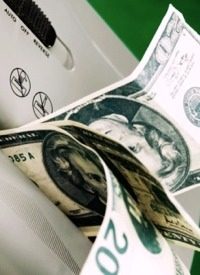
We dont have to hire historians to see where deficit spending will take us. We have only to look around now. Since the end of World War II, some of history’s greatest national disasters have taken place right here in the Americas. North Americans used to laugh or shake their heads at the economies of the south that seemed always on the brink of collapse. Banana republics, we derisively called them. We’re not laughing now.
Here are some examples he provides of inflation lag time:
According to the October report from the U. S. Department of Labor, inflation remains essentially unchanged over the last twelve months.
The real question is: Why not? Where is the inflation? Didn’t the supply of money more than double over the same time period? What’s going on?
Voltaire said: "If you would converse with me, define your terms." And so let’s start with inflation.
In the current public discussion about inflation, there are essentially only two schools of thought. Gary North put it succinctly:
Austrian School economists define inflation as an increase in the supply of money. All other schools of thought define inflation as ìan increase in our favorite price index.
"In almost every Western country in the years following World War II," he continues, "prices have risen. This is because the money supply has increased in these countries. A steady, long-term increase in the price level is always [emphasis added] the result of an expansion of the monetary base by the central bank. [This newly created money] is then spent into circulation [and is] multiplied through the fractional reserve banking system. On this, virtually all economists are agreed."
And, according to the Federal Reserve Bank of St. Louis (the statistical reporting division of America’s central bank, the monetary base has virtually exploded, from about $850 Billion to over $2,000 Billion, since September of 2008.
But, from the Bureau of Labor Statistics comes this news release dated November 18th: "The Consumer Price Index [the favorite price index used by the government] has decreased 0.2 percent over the last 12 months."
How is that possible? What is really going on here? Believe this or not, but President Obama nailed it in this recent comment: "If we keep adding to the deficit … at some point, people could lose confidence in the U.S. economy in a way that could actually lead to a double-dip recession."
Meredith Whitney, CEO of Meredith Whitney Advisory Group, LLC, wrote recently in the Wall Street Journal:
I follow credit, and credit is contracting. Access to credit is being denied at an accelerating pace….
Since the onset of the credit crisis over two years ago, available credit to small businesses and consumers has contracted by trillions [emphasis added], and that phenomenon is reflected is dismal consumer spending trends….
In the past two years, credit-card lines have been cut by over $1.25 trillion. During the same time, 10% of all credit-card accounts have been cancelled.
Furthermore, Whitney says, "I believe that we are only in the early stages of the second half of this credit [contraction] cycle. I expect another $1.5 trillion of credit-card lines to be removed from the system."
If Whitney is correct, the next question in all of this must be: "When can we expect price inflation to begin? The monetary inflation has already occurred — so when does it show up in the prices we pay at the store?"
Harry Figgie, in his book Bankruptcy 1995, provides us with some unsettling clues and a possible glimpse into our future:
Bolivia
Inflation at the retail level (price inflation) was nearly zero in 1977 while the government increased the monetary base (monetary inflation) enormously. However, by the beginning of 1981, price inflation soared to an amazing 11,749% per year!
Argentina
Price inflation actually went negative (deflation) from 1977 — 1980 while the Argentine central bank greatly increased the monetary base. That increased supply of money didnít "hit the streets," however, until 1982. But by 1985 the annual price inflation rate was 672%.
Brazil
While Brazil’s central bank was expanding the monetary base in the late ’70s, price inflation stayed relatively under control, but by 1985 Brazil’s "street" inflation rate was 227%.
Can this happen here?
Ludwig von Mises, the father of the Austrian School of economics, put it this way:
They [consumers] become suddenly aware of the fact that inflation is a deliberate policy and will go on endlessly. A breakdown occurs. The crack-up boom appears. Everybody is anxious [now] to swap his [paper] money against real goods, no matter whether he needs them or not, no matter how much money he has to pay for them. Within a very short time, within a few weeks or even days, the things which were used as money are no longer used as a media of exchange. They become scrap paper.
History repeatedly shows that once paper money becomes worthless, gold and silver reassume their rightful place as the media of exchange. That is why the Founders wrote this into the Constitution (Article I, Section 10): "No state shall … make anything but gold and silver coin a tender in payment of debts…"
The ultimate question, however, remains: Will the United States have to live through this destruction of currency and economy before it is returned to righteous money?



